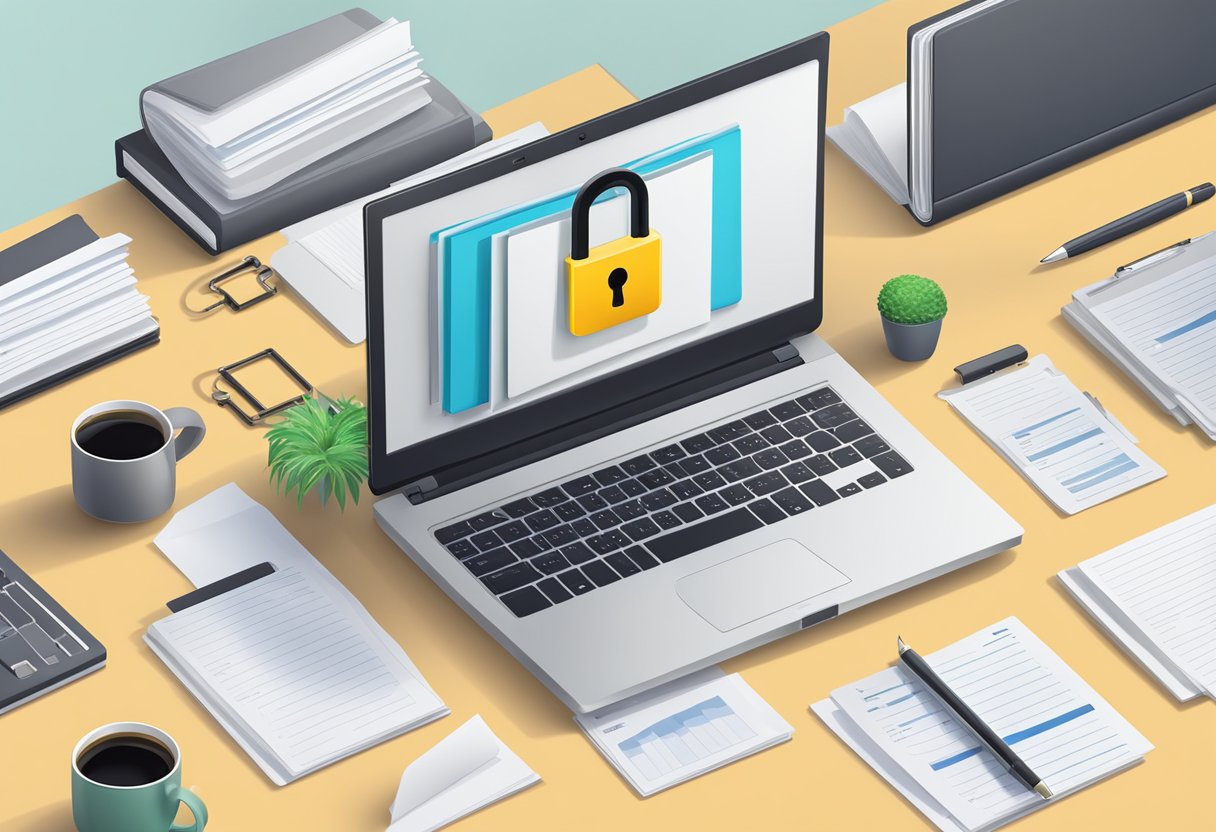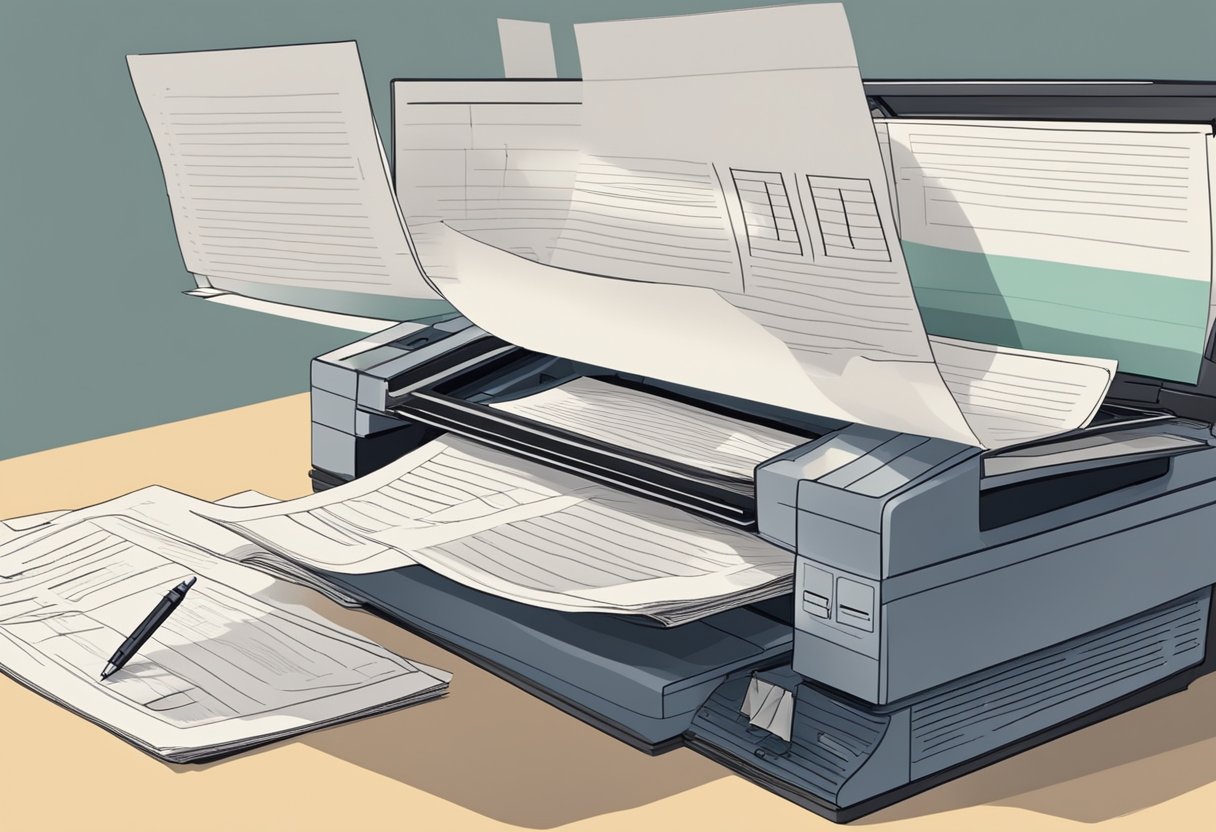Understanding the Importance of Protecting Documents

What Constitutes Important Documents
Important documents are records that contain sensitive personal and financial information. Examples of these documents include:
- Social Security Cards
- Birth Certificates
- Passports
- Tax Forms
- Bank Statements
- Legal Contracts
- Medical Records
These types of documents need to be protected from unauthorized access to prevent identity theft and other forms of fraud.
Why Protection is Necessary
As more and more of our daily activities move online, it’s essential for me to take measures to safeguard my important documents. With the increasing amount of information stored digitally, identity theft and other malicious activities have become more common. If my critical documents fall into the wrong hands, thieves can use my personal information to take out loans, make unauthorized purchases, or open bank accounts using my identity.
To avoid these issues, I must ensure my documents are secure from unauthorized access. This can involve encrypting sensitive files, using complex passwords, and employing multi-factor authentication.
Risks of Identity Theft and Fraud
By not safeguarding my important documents, I expose myself to the risks of identity theft and fraud. These risks include:
- Lost money: Thieves using my information can drain my bank accounts, make unauthorized purchases using my credit cards, or take out loans in my name.
- Damaged credit: Fraudulent activity can lead to a lower credit score and make it difficult for me to secure loans or lines of credit in the future.
- Reputation damage: Identity theft can lead to criminal charges or legal actions that can negatively impact my personal and professional life.
- Time-consuming resolution: Recovering from identity theft can be a lengthy process, requiring me to close accounts, dispute charges, and work actively to repair my credit.
To protect myself from these risks, it’s essential for me to safeguard my important documents and ensure they remain secure from unauthorized access.
Physical Document Storage Options

When it comes to keeping my important documents safe, I have several physical storage options to choose from. Some of the options include:
-
Safe: A home safe is an excellent choice for securing important documents. It can protect my files from fire and water damage as well. When shopping for a safe, I should consider checking for fireproof and waterproof features to ensure maximum protection for my documents.
-
Filing cabinets: While not as secure as a safe, filing cabinets provide an organized space for storing my documents. They come in various styles and sizes, making it easy to find one that fits my needs and space constraints.
-
Lockbox: A home lockbox is a compact, portable storage option that offers some level of protection against theft and damage, often with a lock and key or password. It’s a suitable choice for storing high-priority documents, such as birth certificates, passports, and Social Security forms.
-
Safe deposit box: Renting a safe deposit box at a local bank provides an off-site storage solution for my important documents. This option ensures added protection against theft and damage, but accessing the files may be less convenient, as it requires a visit to the bank during business hours.
To maintain a neat and organized storage space, I like to follow these steps:
- Gather all my important documents in one place.
- Sort and categorize the files according to their nature and importance.
- Label each file or document clearly for easy identification.
- Store them in the storage option of my choice, ensuring they are accessible when needed.
By exploring these physical document storage options, I can determine the best method for keeping my important documents safe and secure according to my specific needs.
Digitalization of Important Documents

As we live in an increasingly digital world, it’s essential to digitize important documents to keep them safe and accessible. In this section, I’ll discuss a few practical steps to help you with this process.
First, a good scanner is your best friend when it comes to digitizing important documents. Look for a document scanner equipped with wireless or ethernet connectivity, color touchscreens, and voice-activated controls. Scanners allow you to create digital copies of paper documents quickly and efficiently.
Once your documents are scanned, you must organize your digital files in a structure that makes sense to you. It’s helpful to create folders based on categories, such as financial records, personal identification, and contracts, to keep your digital files tidy and improve searchability.
There are several key benefits to having a digital backup of your important documents, including:
- Easy access from anywhere
- Increased safety from physical damage or loss
- Simplified sharing with necessary parties
- Streamlined organization and searchability
Here’s a step-by-step process to digitize your important documents:
- Gather all of your important documents in one place.
- Choose a high-quality document scanner or scanning app.
- Scan each document clearly and save it as a digital file.
- Organize your digital files into a logical folder structure.
- Backup your digital files using cloud storage or external drives.
Finally, make sure you have a robust digital backup plan for your important documents. Using cloud storage services, like Google Drive or Dropbox, is an excellent option for automatically backing up your digital files, as they can be accessed from anywhere with an internet connection. Additionally, you can supplement your cloud storage with periodic backups to an external hard drive to ensure the safety and longevity of your important documents.
By following these steps, you’ll have peace of mind knowing that your important documents are safe, easily accessible, and well-organized in the digital realm.
Securing Online Document Storage
When it comes to keeping important documents safe online, I always focus on a few key principles. The first step is choosing a reliable and secure cloud storage service. There are plenty of cloud services available, but some of the best ones include:
- Google Drive
- Microsoft OneDrive
- Dropbox
- Amazon Cloud Drive
To ensure my documents are protected, I follow these steps:
-
Password-protect the important documents: Before uploading any sensitive documents to the cloud, it’s a good idea to add a layer of protection by password-protecting them. Many software programs, such as Microsoft Word and Adobe PDF, have built-in features that allow you to secure your documents with a password. This ensures that even if someone gains access to your cloud storage account, they won’t be able to open your password-protected files without the correct password.
-
Enable two-factor authentication (2FA) for your cloud storage account: I always enable 2FA on my cloud storage accounts. 2FA adds an extra layer of security by requiring a unique code (usually sent to your mobile device) in addition to your password when logging in. This helps keep unauthorized users from gaining access to your account, even if they know your password.
-
Limit access to specific individuals: Cloud services tend to have excellent sharing options that allow you to grant different levels of access to specific people. I make sure to only give access to people who absolutely need to see the documents, reducing the risk of unauthorized access. Additionally, I use the “view-only” options whenever possible to ensure others can see the documents without being able to edit or download them.
-
Regularly review activity and permissions: With my cloud storage, I periodically review the activity log to keep an eye on any unfamiliar actions or access attempts. This helps me stay aware of potential security issues and take action when needed.
In conclusion, selecting a reputable and secure cloud storage service is essential for keeping important documents safe online. By following the steps outlined above, I have been successful in maintaining the security and integrity of my sensitive files. Remember, being proactive about online safety is crucial in today’s digital landscape.
Creating an Organized Filing System
As someone who values organization and document safety, I’ve established an effective filing system for my important documents. Let me share with you the essential steps in creating an organized filing system.
First, it’s important to categorize your documents. Start by sorting them into broad categories such as financial, legal, and personal. Within each category, you can create subcategories for specific types of documents, like bank statements or tax returns under the financial category. Be sure to clearly label each file folder to easily locate documents.
Next, invest in a good document organizer. I personally use hanging file folders in a filing cabinet to keep all my papers in order. Hanging file folders allow for easy access and can be color-coded for better organization.
Here are some essential tools to support your filing system:
- File folders: Use different colors for each category, making it easier to find documents quickly.
- Labels: Clearly label each folder and use a consistent naming system for better organization.
- Expanding files: These can accommodate bulkier documents and keep them well sorted.
Don’t forget to maintain your filing system regularly. Filing your documents as soon as you receive them prevents clutter, and scheduling time for regular maintenance ensures your system remains effective. Consider performing a yearly audit to discard outdated documents and update the necessary files.
Lastly, consider digitizing your filing system using a digital filing system which makes your important documents easily accessible and adds an extra layer of security by storing them online. I always make sure to back up my digital documents to a secure cloud storage service to ensure their safety.
By following these steps and tailoring them to your personal needs, you will create an organized and secure filing system for your important documents. It takes commitment, but I find the peace of mind well worth the effort.
Specific Document Safety Measures
As someone who is concerned about keeping important documents safe online, I always take certain measures to ensure their security. Storing important digital files such as bank statements, tax returns, medical records, insurance policies, legal documents, property records, estate planning documents, and business documents requires extra attention to detail and the use of proper tools.
First and foremost, I make it a point to use strong passwords for all my online accounts. This includes using a combination of uppercase and lowercase letters, numbers, and special characters. It’s also crucial to avoid using the same password for multiple accounts to minimize the risk of a single breach compromising multiple files.
Next, I regularly backup my important documents. This serves as an invaluable safety net in case the originals get compromised or lost. Creating backups is essential, and I make sure to store them in a secure location, protecting them under the same provisions as the original files.
To stay organized, I categorize my documents based on their type and importance. Here’s an example of how to organize these documents:
- Financial documents
- Bank statements
- Tax returns
- Personal records
- Medical records
- Insurance policies
- Legal and property documents
- Legal documents
- Property records
- Estate and business documents
- Estate planning documents
- Business documents
I also utilize encryption to protect the contents of my important files. Encrypting the files prevents unauthorized individuals from accessing and tampering with my sensitive information. Some tools I use for encryption are the built-in encryption features of my operating system and third-party software solutions.
Lastly, I opt for trusted cloud storage services or secure online storage providers to save my files. With these services, I can store, access, and share my important documents from any device with an internet connection. It’s essential to choose a reliable storage provider that offers robust security measures, such as end-to-end encryption, two-factor authentication, and strong data protection policies.
By following these specific document safety measures, I’m confident that my important files are safe and secure online.
Storing and Protecting Personal Identification Documents
It’s essential to store your personal identification documents securely, while also protecting them from unauthorized access. I’ll cover some ways to do this for important documents such as birth certificates, passports, social security cards, marriage certificates, and green cards.
Firstly, I recommend using a cloud storage service, like Google Drive or Dropbox. Both of these services provide encryption for data stored on their platforms and have strict security measures in place. Storing your documents online makes them easily accessible to you whenever needed while keeping physical copies safe.
Next, when storing identification documents online, it’s crucial to safeguard them with a strong password. Choose a unique and complex password, ideally one that contains a combination of upper and lower case letters, numbers, and special characters. To further increase security, I suggest enabling two-factor authentication where available. This adds an additional layer of security by requiring a code from your mobile device each time you log in.
To protect digital copies of personal identification documents, take the following steps:
- Scan or photograph each document.
- Save the scans in a dedicated folder within the chosen cloud storage service.
- Encrypt the files using tools like 7Zip (for Windows users) or FileVault (for Mac users), adding a unique password for each file.
- If possible, use access controls to limit the number of users who have access to the folder.
While digitally storing personal documents is an essential first step, it’s also crucial to safeguard physical copies. Keep physical documents in a fire-safe lockbox or a safety deposit box at your bank. Fire-safe lockboxes can withstand high temperatures and protect documents from water, while safety deposit boxes provide a secure off-site location.
In summary, proper storage and protection of personal identification documents involve both digital and physical security. By taking precautions like utilizing cloud storage, encrypting files, and securing physical documents, it’s possible to keep your essential documents safe and readily accessible when needed.
Key Tips for Safeguarding Documents Against Disasters
As a professional who values the safety of my important documents, I have gathered a few key tips to help protect files in case of disasters. By taking these precautions, you can ensure that your important documents remain safe and accessible, even if you face a disaster in your home or office.
The first thing I recommend is creating digital copies of all your essential documents. This can be done using a scanner or by taking clear photos with your smartphone. Be sure that all important details are readable in these digital copies and store them securely on a cloud service or an external hard drive. Making use of a service like Adobe Acrobat can be helpful in organizing and safeguarding digital files.
Additionally, storing the original documents in waterproof and fire-resistant containers is vital. Investing in quality fireproof safes or safety deposit boxes is strongly recommended. When choosing a location for these containers, consider placing them as high as possible within your home or office to minimize the risk of water damage.
To further strengthen your home security, I’d like to share the following tips:
- Install a reliable security system with cameras and an alarm, continuously monitoring potential threats.
- Regularly update passwords and login details for all accounts linked to your digital files.
- Consider the use of end-to-end encryption for sensitive information.
Now, let’s talk about organizing and protecting your physical documents. Here’s a list of steps to take:
- Sort your essential documents into categories, such as financial, legal, and personal.
- Use sheet protectors, plastic sleeves, or binders to keep papers secure and in good condition.
- Label folders and containers clearly for easy identification.
- Regularly review and update your documents to ensure the information is accurate and up-to-date.
In conclusion, by following these key tips and precautions, you’ll be able to create an efficient and reliable way to safeguard your important documents against disasters, ensuring the safety of your digital and physical files for years to come.
Frequently Asked Questions
What are the top methods for securing crucial files online?
There are several ways to ensure that your important files are safe online. Some of the top methods include:
- Using strong, unique passwords for each account and updating them regularly.
- Enabling two-factor authentication, which adds an extra layer of security.
- Storing files on encrypted online document storage1.
- Keeping your devices and software up-to-date with the latest security patches.
Which online platforms offer the highest level of safety for storing documents?
Several reputable online platforms provide a high level of safety for storing documents. Some examples include:
- Google Drive
- Dropbox
- Microsoft OneDrive
- Box
- Folderit2
When choosing an online platform, be sure to compare their security features, encryption methods, and user reviews to find the best one for your needs.
How can I use encryption to protect my valuable documents online?
Encryption is a vital step when it comes to protecting your valuable documents online. To utilize encryption:
- Choose a document storage platform that offers built-in encryption1.
- Use encryption software to encrypt files locally on your device before uploading them to the cloud.
- Securely manage and store encryption keys to ensure only authorized access to your files.
What steps can I take to prevent unauthorized access to my digital files?
To prevent unauthorized access to your digital files, follow these steps:
- Always use strong, unique passwords for each of your accounts.
- Enable two-factor authentication1.
- Regularly review and update your account permissions and user access.
- Make sure your devices and software are updated with the latest security patches.
Are there any essential features to look for in online document storage services?
When evaluating an online document storage service, consider the following essential features:
- Encryption and security measures.
- Backup and recovery options.
- Ease of file access and sharing.
- Collaboration tools.
- Scalability and storage capacity.
- Pricing and plans that suit your needs.
How can I ensure my documents’ safety in the cloud?
To ensure your documents’ safety in the cloud:
- Choose a reputable cloud storage provider that prioritizes security and encryption2.
- Encrypt your files before uploading them to the cloud.
- Use strong, unique passwords and enable two-factor authentication.
- Regularly backup your valuable data for added security.
- Monitor and update permissions and user access for your stored files.
By following these tips, I can increase the safety of my important documents when storing them online.
Footnotes
- Shopify Reviews: Unbiased Evaluation for Online Merchants - May 2, 2024
- Hyperliquid Trading Vaults - April 25, 2024
- Outsmart the Spy: How to Block Tracking Pixels Effectively - April 16, 2024







